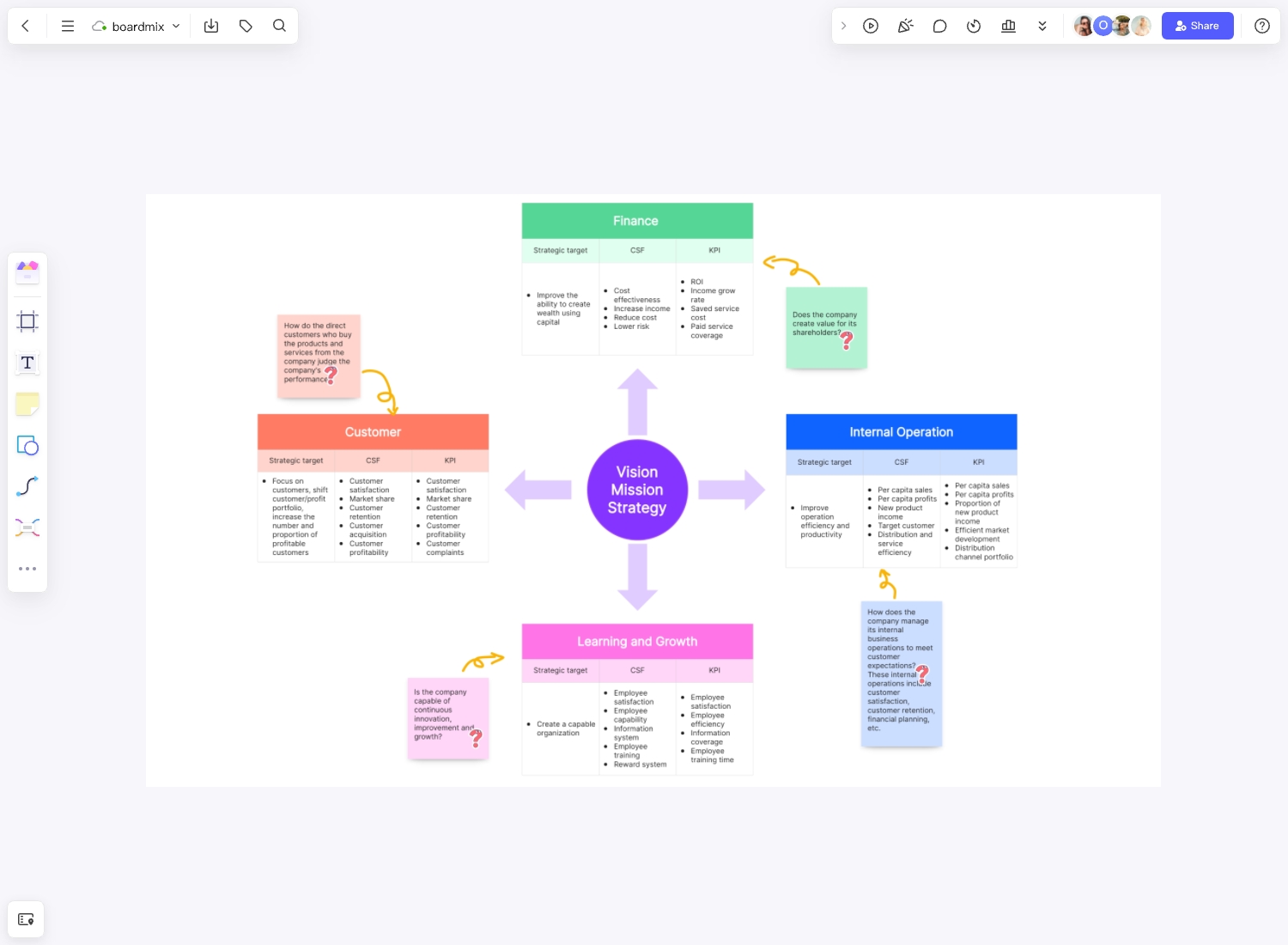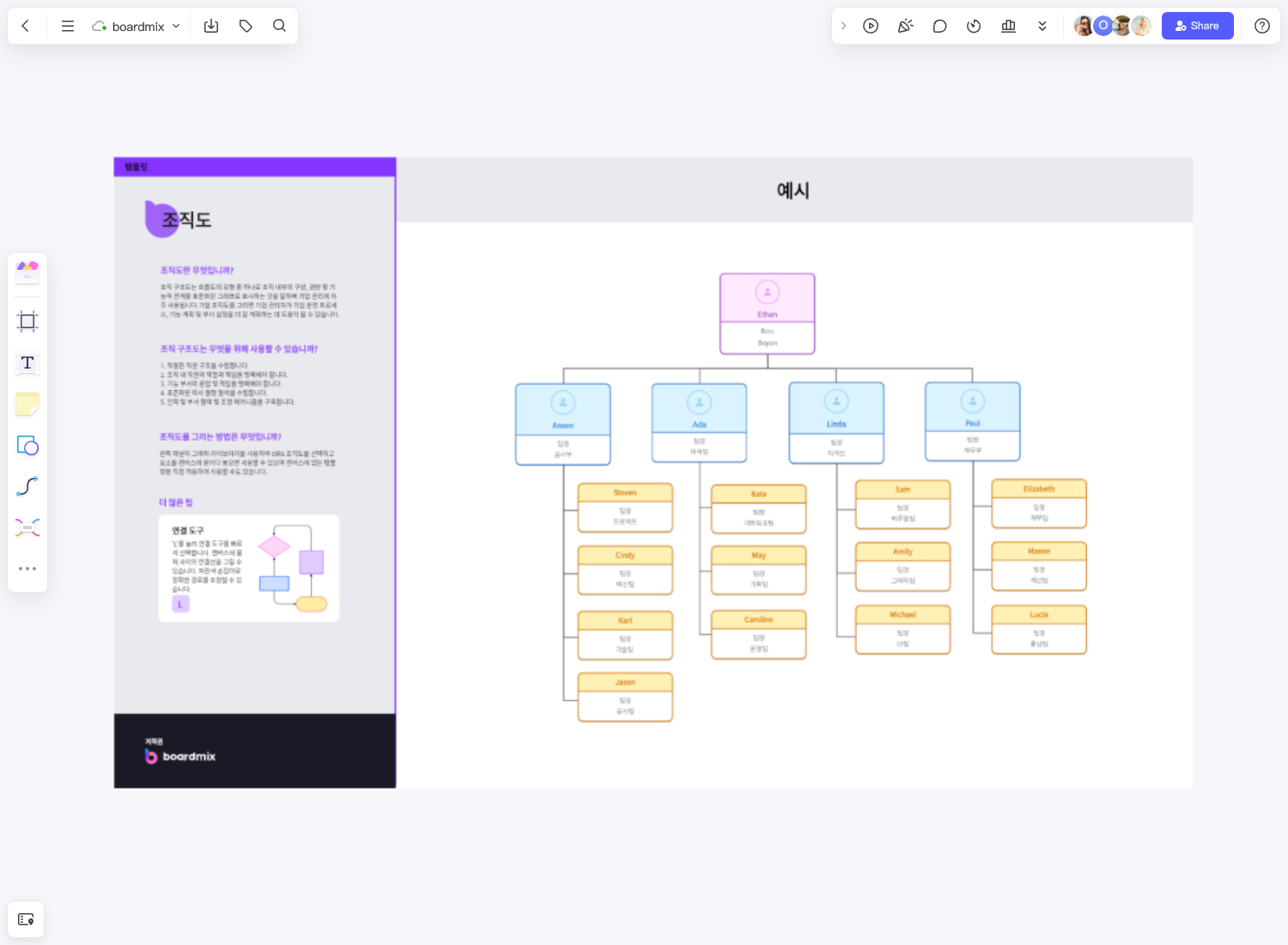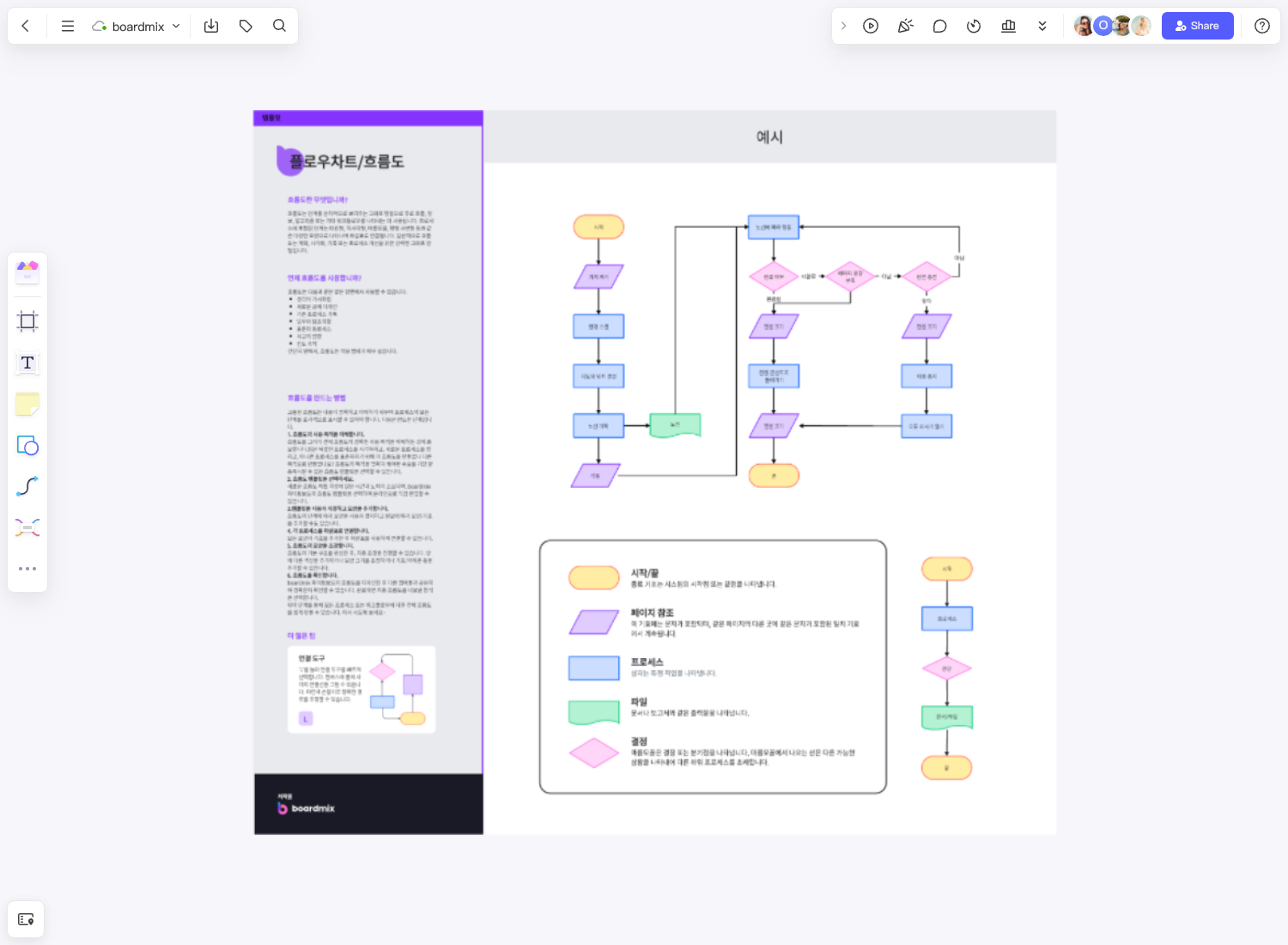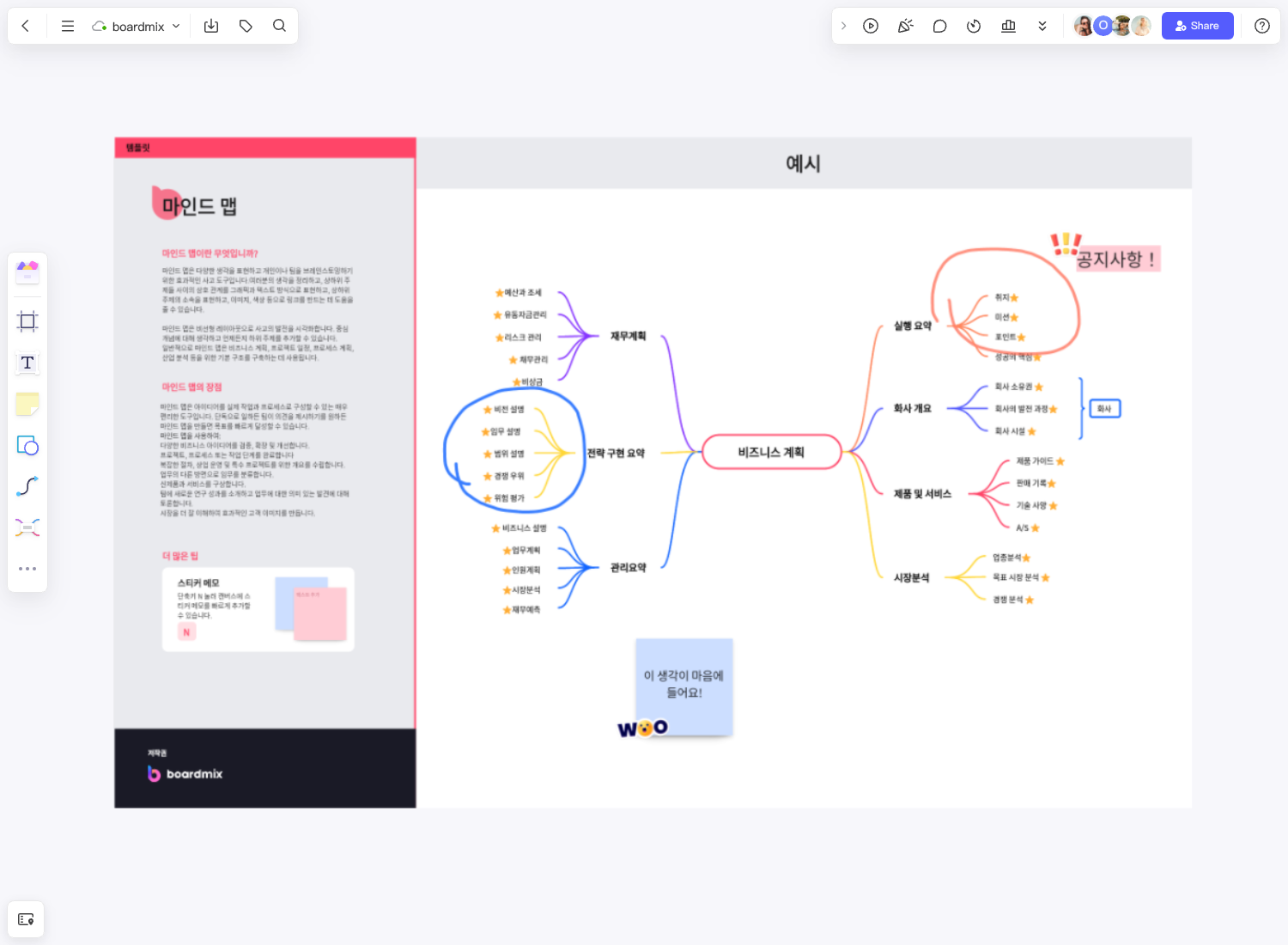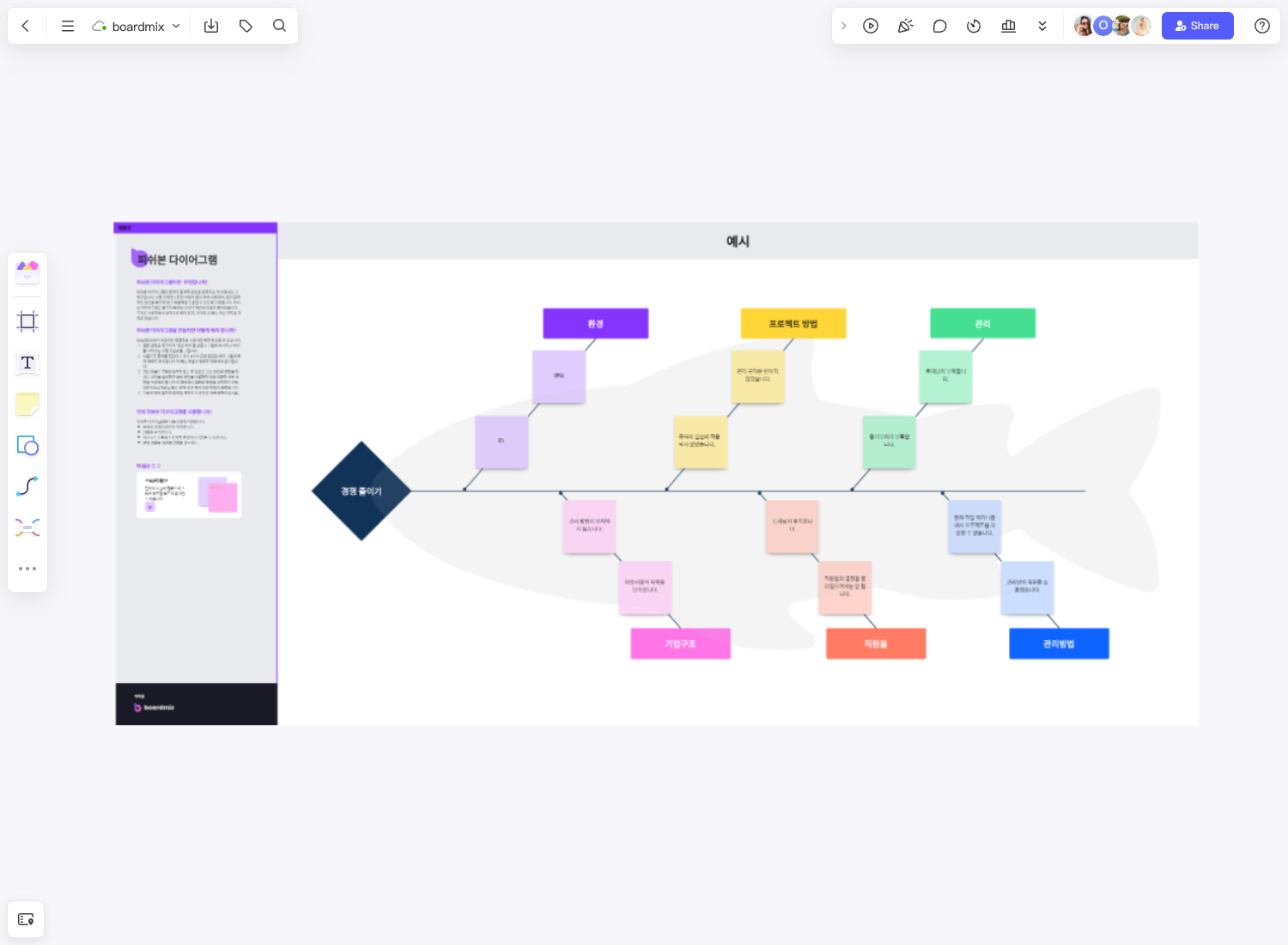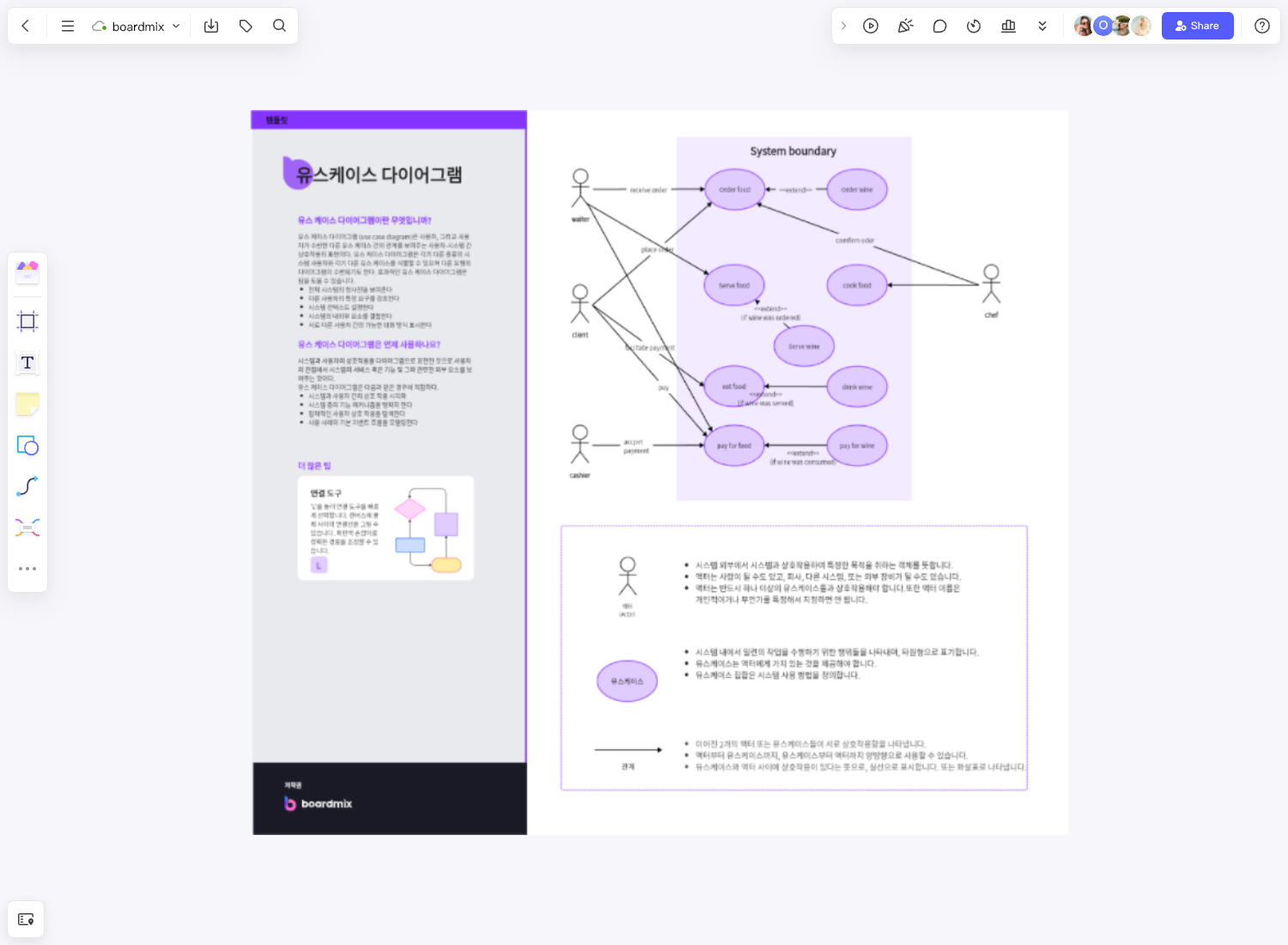At first glance, balanced scorecards or BSCs are usually used in businesses and industries. However, this template is also utilized in nonprofit organizations and government institutions. A balanced scorecard template's popularity means it works in most organizations. The key is to know how the template and best practices flesh out the concise information from the diagram.
What is the balanced scorecard?
A balanced scorecard is a unique strategic management and planning framework that allows institutions to communicate better what the group hopes to complete, prioritize tasks and projects, assess the progress of strategic initiatives, and align members' daily work with the organization's overall strategy.
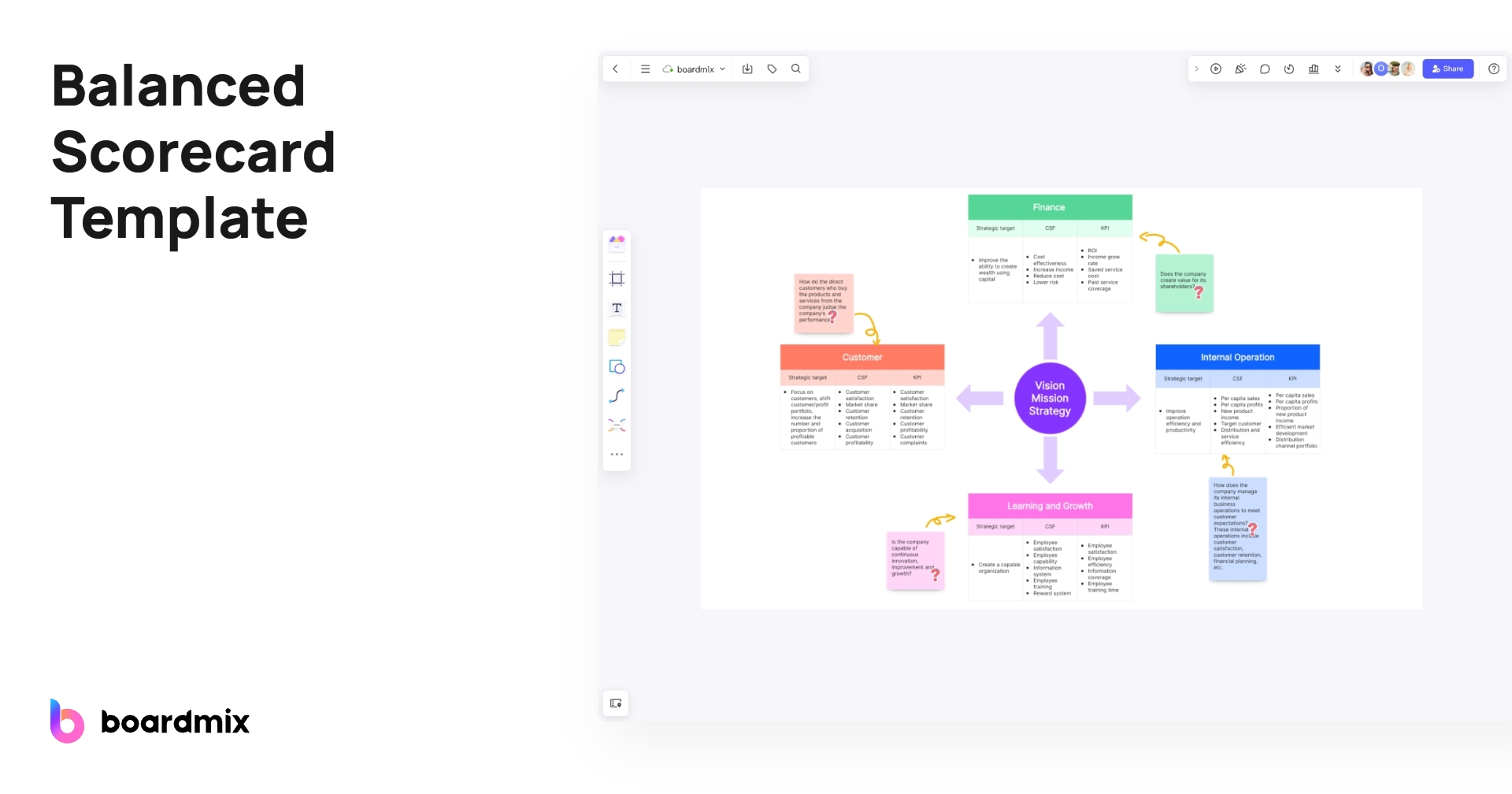
Build Balanced Scorecard for Free
The framework aims to balance strategic developments with financial progress so decision-makers can see the organization's performance. Using the diagram, you'll connect strategic planning initiatives with daily management.
The main components of a balanced scorecard
When making a balanced scorecard template, there are four main areas in which your team must provide specific information. See the list below.
Finance
Financial data like expenditures, income, and sales are used under this component to understand the organization's financial performance. The metrics show whether the business's strategy and implementation contribute to improving business profits. Most importantly, the data in this section helps see if there are lapses in the financial aspect of the organization so they can quickly create initiatives to correct them.
Customer
Most businesses collect customers' perspectives to gauge satisfaction regarding the price, quality, and availability of services and products. This space in the balanced scorecard template will have feedback on customer satisfaction with the existing products involved. Along the way, it allows business managers to understand customers better and provide marketing strategies that can generate considerable financial returns.
Internal Process (Internal operation)
Efficiency and quality in the organization's business processes constitute this section in the diagram. Managers will identify the significant internal processes in which the organization excels in. Furthermore, managers will analyze operational management to track possible gaps, bottlenecks, delays, waste, or shortages.
Learning and Growth
Employee performance records show a transparent framework to keep track of their success and satisfaction. Monitoring employees' performance will help facilitate growth and learning toward the team's overall goal. Team managers also keep track of team members' turnover and morale, their knowledge levels, and their effectiveness in using the company's best practices.
Balanced Scorecard Examples
If you're new to this framework, you can get inspiration from the balanced scorecard examples of companies below. Remember that you can choose an editable scorecard example online, so it's easier to modify items when necessary.
Balanced scorecard for a manufacturing company
As you can see from the balanced scorecard example above, there are four in the framework. These are the four components your team must fill out. Each component has objectives or goals and specific initiatives the team needs to perform to achieve these goals. The balanced scorecard example is of a manufacturing company that aims to enhance customer satisfaction by examining metrics like on-time delivery rates, customer retention, and number of customer complaints. The diagram does not use many colors, which can be beneficial since, as a creator, you must guarantee to relay the significant details of the illustration.
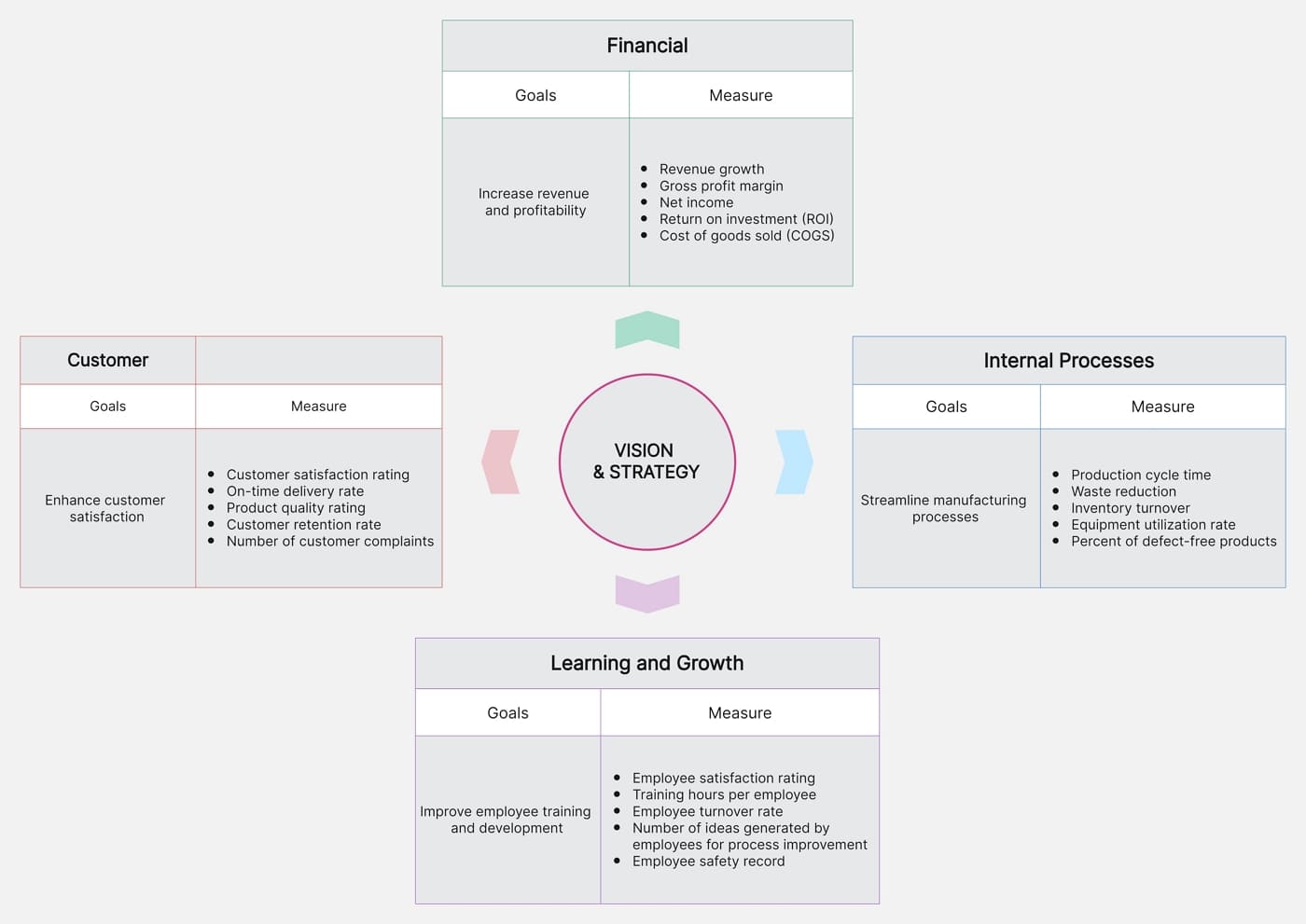
Build Balanced Scorecard for Free
Balanced scorecard for an e-commerce business
You can also create scorecard examples like the one above, which uses light and pastel colors. Generally, it's visually appealing. The diagram provides multiple goals for every component, which you can do with your balanced scorecard. As you can see, the plans provided are more specific, which benefits the organization. The more detailed the inputs, the better the programs and activities will be implemented.
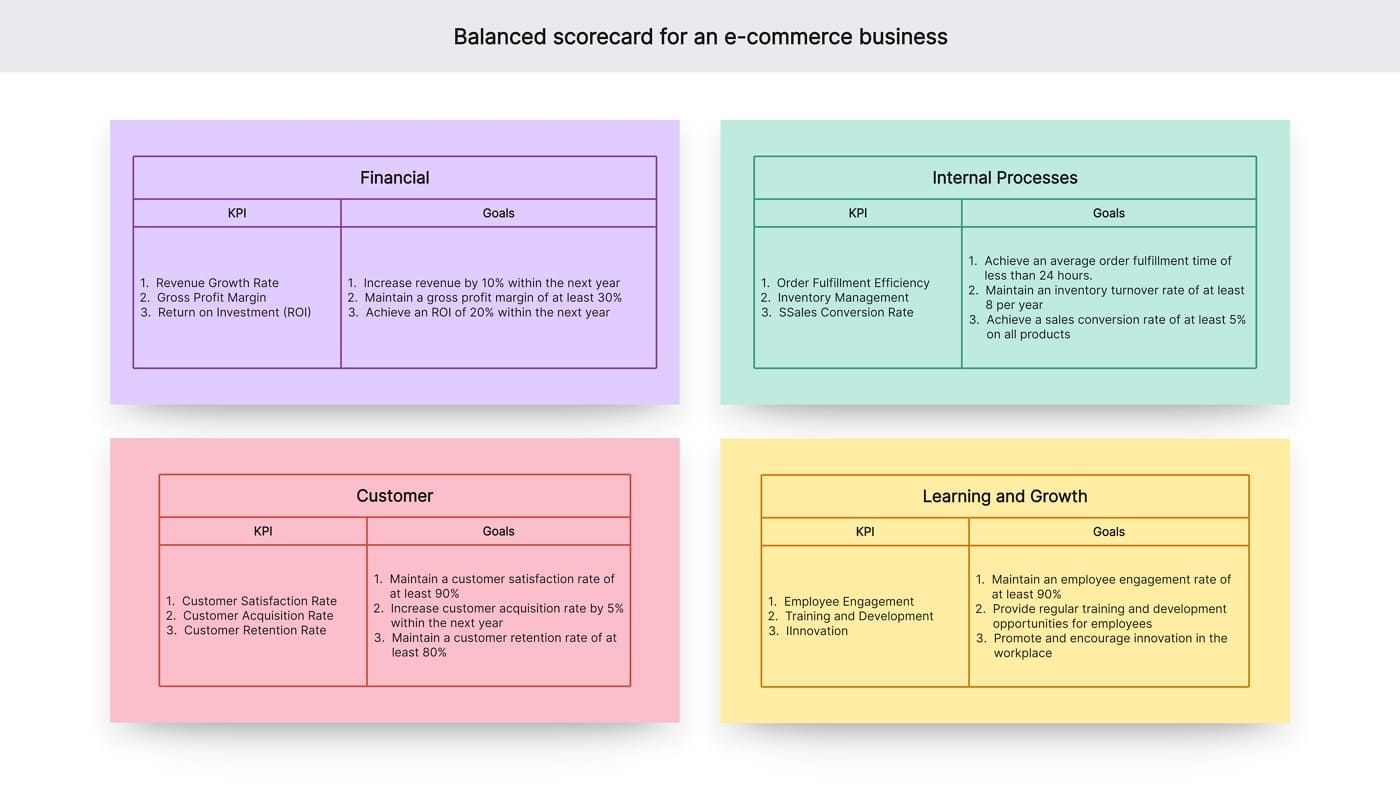
Balanced scorecard for a software company
Balanced scorecard examples of software companies can also look like the framework above. As you know, there is diagramming software today which allows you to create scorecards using different shapes. For every objective identified, specific goals are mentioned in the diagram that the software company must achieve. The good thing about the illustration above is it includes the target numbers and percentage the group aims to achieve. As a result, you'll have a precise gauge when implementing your marketing strategies.
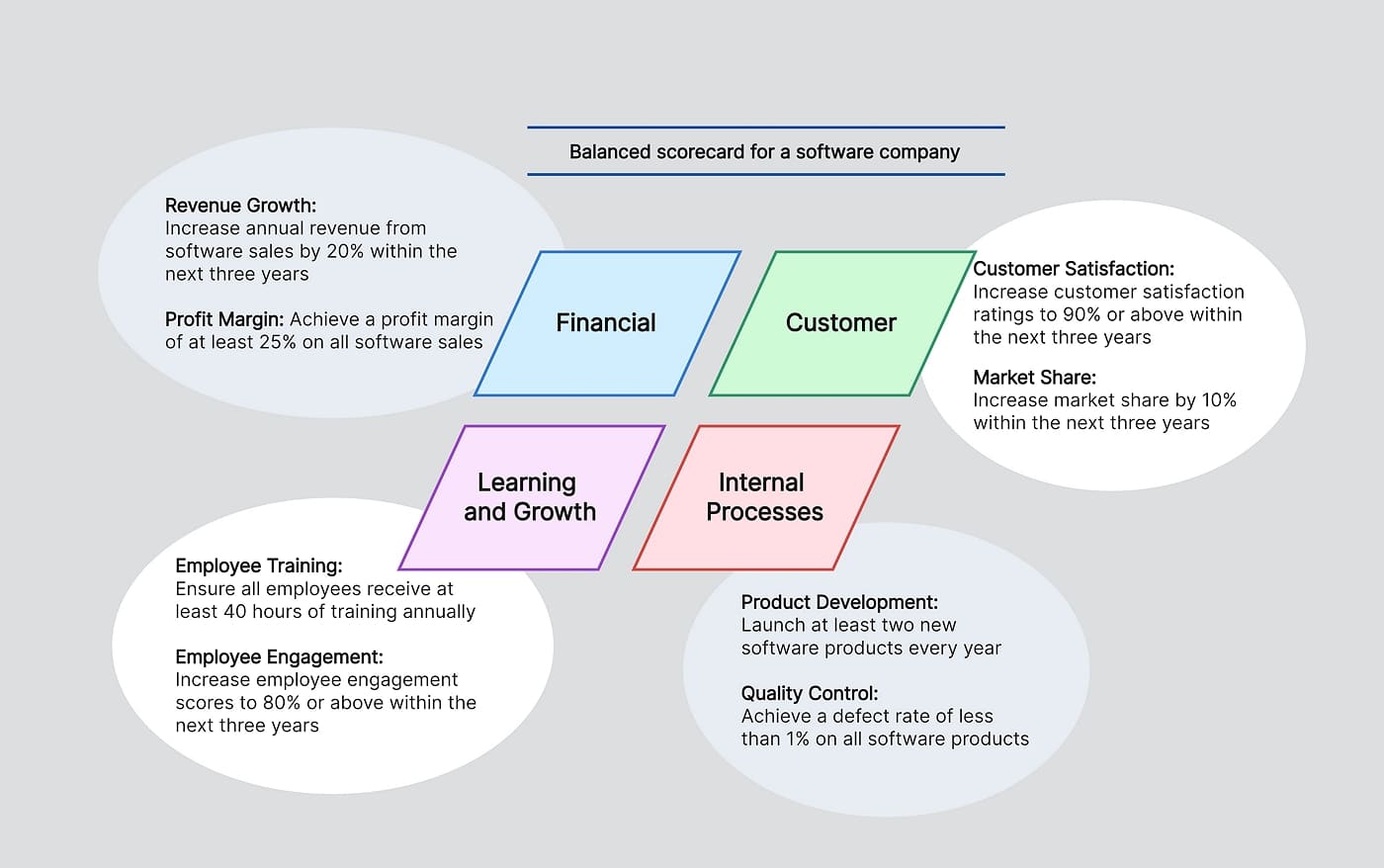
Balanced scorecard for the construction industry
At first glance, it's closely similar to mind maps. Yes, you can use mind mapping to create your balanced scorecard examples of companies in the construction industry. It's evident in the structure that the company focuses on various factors to assess its current performance in specific areas. For example, the team must look into its cost control, cash flow, ROI, profit margins, and revenue growth to see how they're performing financially. Of course, every construction company differs, so you may add or delete some inputs above.
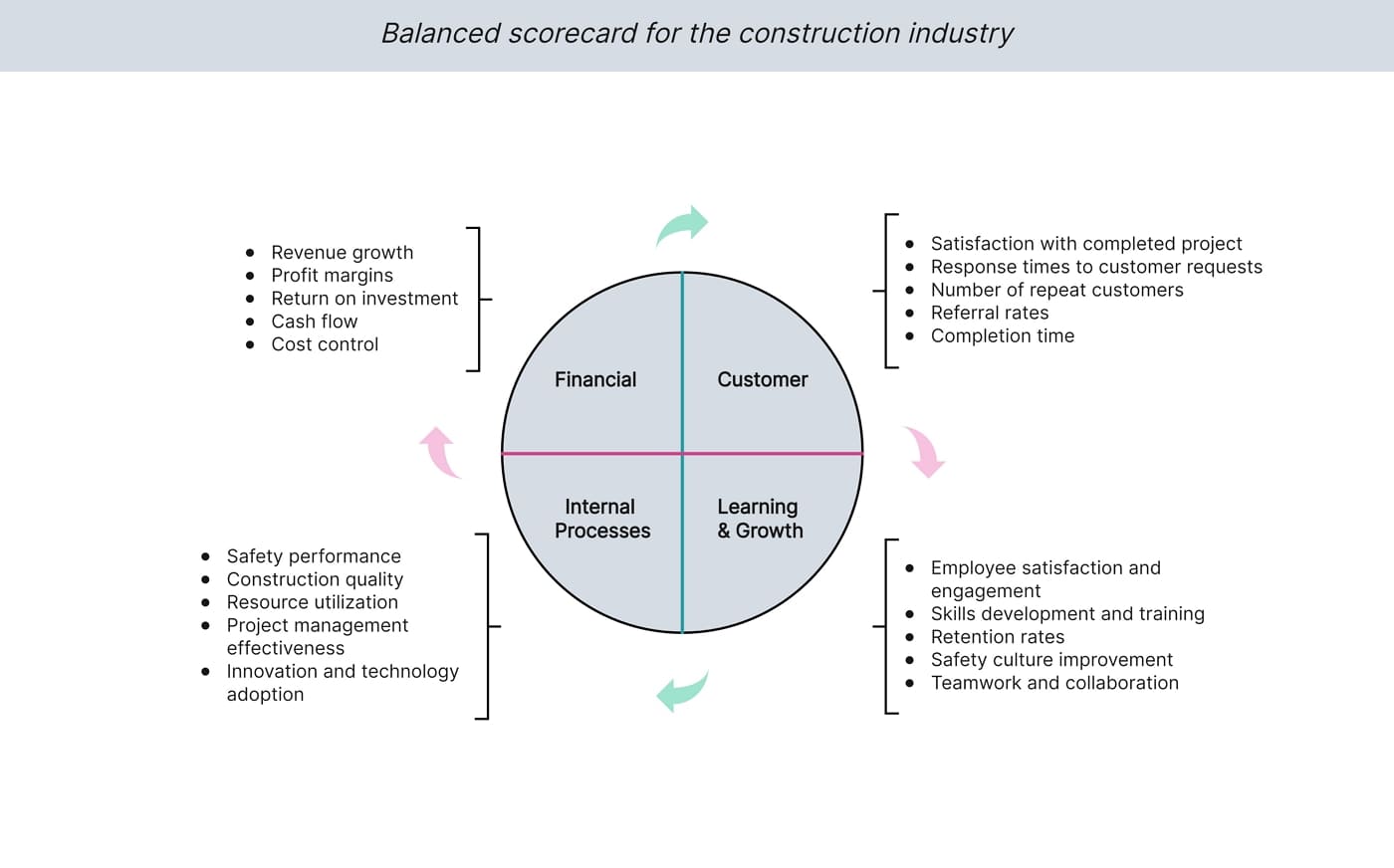
Build Balanced Scorecard for Free
How do I create a balanced scorecard template?
Creating a Balanced Scorecard template involves several steps. Here is a simple guide to help you:
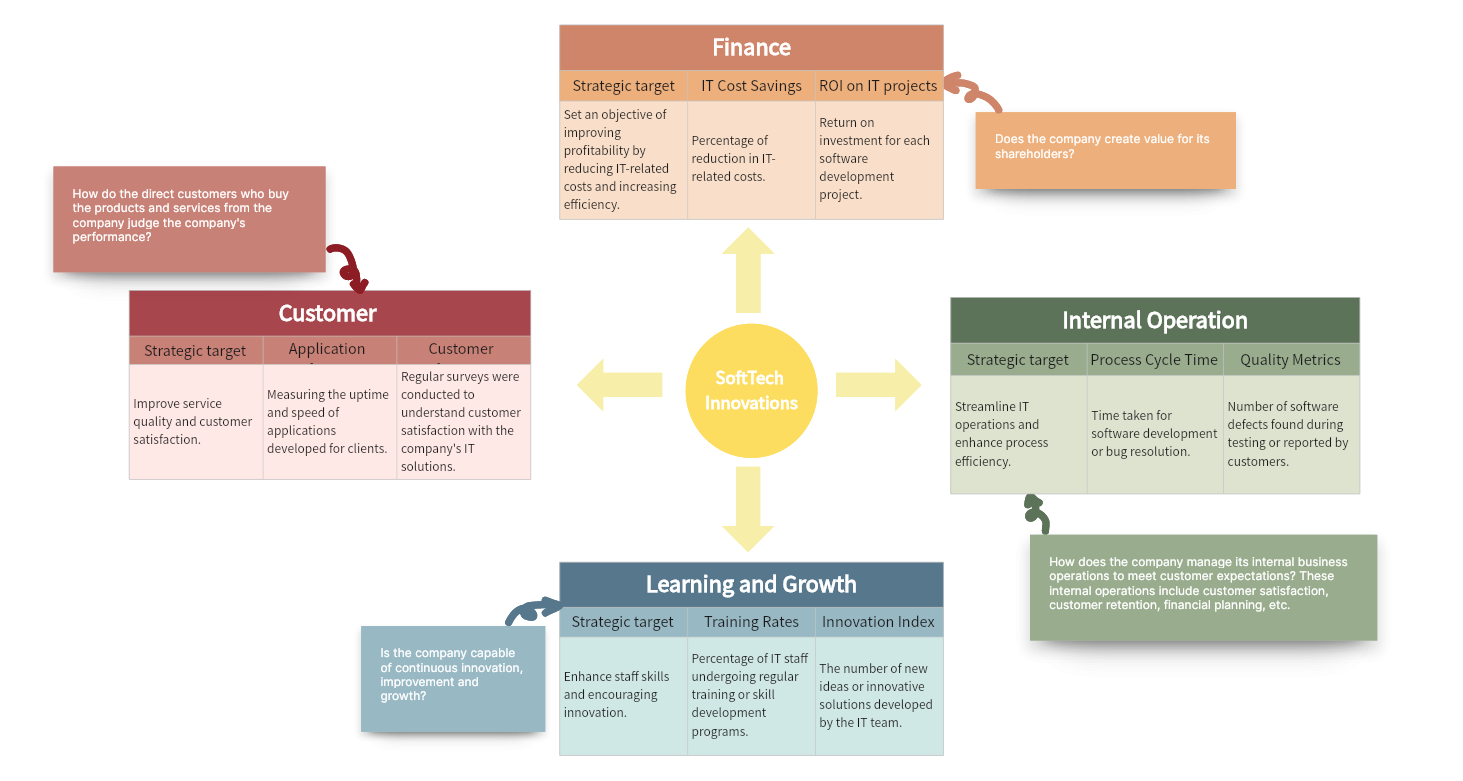
-
Identify your strategic objectives: Your first step should be to clearly define what you want to achieve. This could range from improving financial performance, enhancing customer satisfaction, streamlining internal processes, or promoting learning and growth within the organization.
-
Define metrics for each objective: Once you've identified your objectives, the next step is to establish measurable key performance indicators (KPIs) for each one. These KPIs will help you track progress towards your objectives.
-
Set targets for each metric: After defining your KPIs, you need to set realistic yet challenging targets for each one. These targets will give you a clear benchmark against which to measure your progress.
-
Create initiatives to achieve targets: Next, identify the actions or initiatives that need to be taken to reach each target. These could be specific projects, programs, or strategies.
-
Implement and monitor: Once your Balanced Scorecard is set up, the final step is implementation and monitoring. Regularly review your scorecard to check progress towards your objectives and make necessary adjustments as needed.
How to use BoardMix's balanced scorecard template
Using a BoardMix Balanced Scorecard template is quite straightforward. Here's a step-by-step guide:
Access the Template: The first step is to access the BoardMix Balanced Scorecard template. You can find it in the BoardMix template library or online. Once you've found it, open it up.

Customize Your Template: Next, you'll need to customize your template to suit your organization's needs. This involves inputting your strategic objectives into each of the four categories: Financial, Customer, Internal Process, and Learning and Growth.
Define Your Metrics: For each strategic objective, define the key performance indicators (KPIs) that will help you measure progress towards that objective.
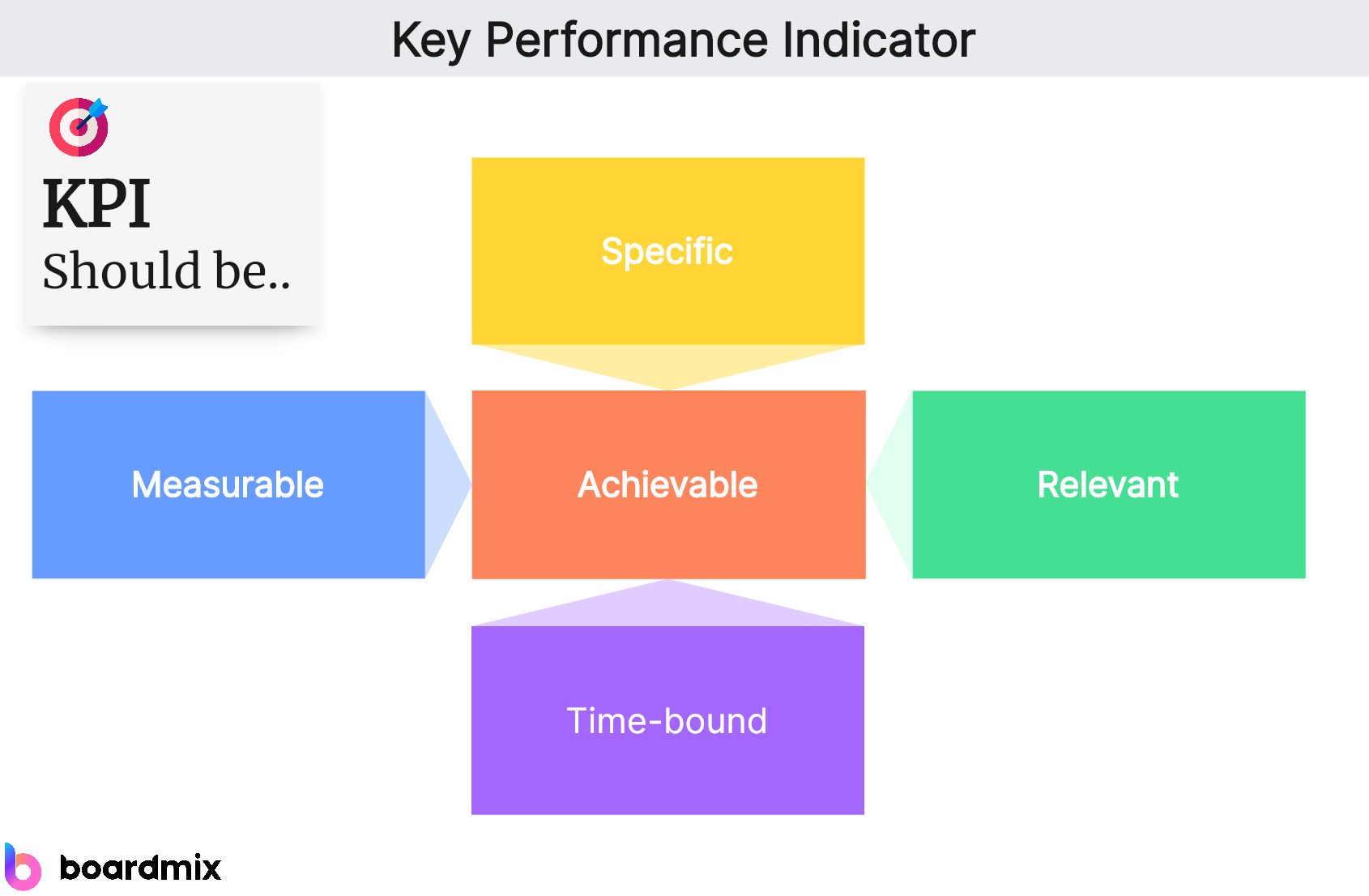
Set Your Targets: After defining your KPIs, set targets for each one. These should be challenging but achievable.
Identify Initiatives: Now, identify what actions or initiatives need to be taken to reach each target. This could involve specific projects or strategies.
Collaborate and Share: One of the great things about BoardMix is its collaborative features. You can invite team members to view and edit the scorecard, fostering a sense of shared ownership and accountability.
Monitor and Update: Once your scorecard is set up, it's important to regularly review and update it based on your progress and any changes in your strategic objectives.
Benefits of a Balanced Scorecard
Improved organizational alignment and focus
When you look at a balanced scorecard sample, you'll see that the framework is made in a series of strategy maps so your team can communicate the strategies. As a result, employees will know where the company wants to go and how each member can contribute to achieving it. In short, using the diagram will have members focus on one goal and the initiatives to fulfill it.
Increased employee engagement and accountability
It may be a team goal, but every organization member generally owns the balanced scorecard template. This means when something goes wrong, you will know who to call. Meanwhile, the team knows who gets the credit if something goes right. The BSC does not only promote accountability but also efficiency in terms of addressing organizational concerns.
Enhanced communication and collaboration
The BSC also serves as an instrument to communicate the group's strategy. Since you're using the strategy map, you can visualize the organization's initiatives on a single page. A balanced scorecard sample visualizes your strategies efficiently, which makes it easier to relay objectives to the whole team. Even external stakeholders can grasp the idea just by looking at the diagram.
Greater strategic agility and adaptability
In market shifts or unexpected events in the industry, using the balanced scorecard sample helps prevent your new strategies from being unbalanced. The diagram gives you and your team the confidence to quickly make the necessary changes while paying attention to other aspects of your business.
Best Practices for Balanced Scorecard Implementation
Clearly define objectives and key metrics
Your team must prioritize the strategic objectives concerning your vision and mission. This includes the high-level results you want to realize in the four main components. For example, the financial goals include reducing costs and increasing revenue. You can consist of loyalty and retention under the customer objectives section. Make the objectives as specific as possible.
Ensure alignment with vision and strategy
As you design strategic initiatives, ensure they align with and support your overall goal. In your balanced scorecard sample, you can consult with team members in the organization for programs, projects, and activities to improve performance and close the evident gaps between the current and desired situations.
Regularly review and update the scorecard
Like in any other situation, marketing conditions and the industry change. With this, you must realize that you must constantly update your balanced scorecard template to adjust to different scenarios effectively. Additionally, this ensures that the scorecard remains relevant, useful, and valid amidst external and internal conditions. As you go along the process of reviewing the diagram, your team also learns and improves from the feedback and results.
Promote organizational communication and collaboration
Creating the scorecard is not a one-person show. It has to be a collection of ideas from all the members involved in creating the diagram. This would mean brainstorming with various departments to develop realistic objectives and initiatives to achieve specific goals. At the same time, every employee must be aware of how your final scorecard looks, including the elements placed for every component.
Identify and prioritize critical success factors
The success factors must be vital to the company's success and should benefit the company or the departments involved. Examples of such factors include increasing market share with current customers and practicing a service-oriented approach when working with the target market.
Most importantly, teamwork will be the key to creating the scorecard. Thanks to technology, you can collaborate with other team members through an editable balanced scorecard template from Boardmix. You can provide edit access to selected members and viewing access for others. It works like a virtual whiteboard which is ideal for brainstorming and collaboration.







